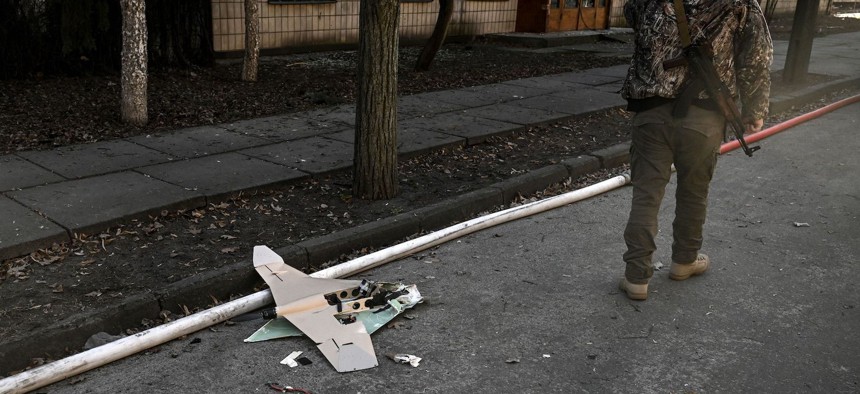
A Ukranian serviceman stands next to a downed Russian drone in the area of a research institute, part of Ukraine's National Academy of Science, after a strike, in northwestern Kyiv, on March 22, 2022. Photo by ARIS MESSINIS/AFP via Getty Images
Russia Seems to Be Running Low on Drones
The Russian military wrote the book on tactical drones in 2014. Now its leaders are begging foreign partners and regional officials to help replace downed UAVs.
Russia, which used drones to terrifying effect in its initial 2014 invasion of Ukraine, appears in the current campaign to be losing both small and large drones at a rapid pace.
Jake Sullivan, the Biden administration’s national security advisor, said on Monday that Iran was preparing to send “several hundred UAVs, including weapons-capable UAVs, on an expedited timeline” to Russia. That’s on top of recent reports out of Russia where regional officials have vowed to dig into their general budgets to buy the Russian Army more quadcopters.
Russia has likely lost dozens of their signature strike drone, the Orlan-10, in the early days of the war, said Sam Bendett, an adjunct senior fellow at the Center for a New American Security and an adviser at the CNA Corporation. They’ve also lost a large percentage of their small fleet of more sophisticated Orion combat drones. He put the losses for the Orion in the single digits but that still makes up a large portion of them.
Sullivan didn’t say what specific drones Russia was seeking from Iran. Tehran is under sanctions of its own, but is still able to manufacture the Shahed-129 and Mohajer 6 heavy-armed drones, the UK’s Royal United Services Institute has said. But if Moscow has requested hundreds of drones, they are probably mostly smaller ones, Bendett said.
“It's likely that Russians are getting lots of loitering munitions. One of the biggest lessons Russians took from the Nagorno-Karabakh war was that mass use of loitering munitions is key to military success,” he said.
Russia appears to have lost many small tactical drones and quadcopters. In June, the Ukrainian military put the number at more than 600.
Don't miss:
It’s gotten so bad that Russia is essentially crowdsourcing quadcopters, similar to the way the Ukranians relied on donated drones from around the world in 2014. Last month, Russian regional officials in Buryatia—a Siberian district far from the action—announced that they would diverte 200 million rubles ($3.4 million) from the general budget to buy quadcopters, gun sights, and thermal imagers for soldiers on the front lines. Bendett said that these drones would likely be widely available DJI Mavic 2s or 3s.
The announcement, carried on the Russian news site Tayga, says that "such (volunteer) support is provided by all regions of the country, and in large volumes," without elaborating further.
That diversion of regional resources to the war effort, under the auspice of patriotic donation, suggests both that Russia’s material losses are beginning to affect the lives of average Russians away from the front lines and also that Russian soldiers are having big problems with intelligence, surveillance, and reconnaissance. The small tactical quadcopters they are seeking can’t see more than about five kilometers. The Tayga article quotes one local official who bemoaned the lack of drone equipment for Russia’s troops. “There are a lot of [Russian soldiers from] the republics of Buryatia and Tuva on the front line, precisely standing on the front line. We, they say, are like blind kittens there. We need, they say, quadcopters.”
Said Bendett: “This unusually open critique of front-line capabilities exposes a gap in tactical ISR capabilities…In many ways, such volunteer aid—whether by individuals or by a regional government—underscores the apparent poor state of readiness for some soldiers on the front lines.”




